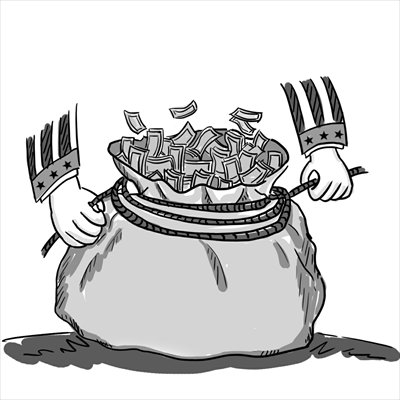Asia's vulnerable markets need financial safety nets

Illustration: Chen Xia/GT
Emerging economies are facing significant uncertainty and serious downside risks. One major source of instability is the looming reversal of the US Federal Reserve's expansionary monetary policy - the prospect of which is generating volatility in global financial markets and threatening to disrupt emerging economy growth.
The Fed has signaled that its federal funds rate will remain near zero percent, at least as long as unemployment exceeds 6.5 percent and inflation expectations remain well anchored. But when and how the Fed will begin tightening monetary policy remains unclear. What is certain is that, in making its decision, the Fed will not consider its policy's spillover effects on the rest of the world, leaving affected countries' policymakers and central bankers to deal with the fallout.
Tighter US monetary policy could intensify the global credit shortage, thereby increasing pressure on Asia's economic and financial systems. Overreaction and herding behavior by market participants could trigger a sudden reversal of capital inflows, with a severe dollar shortage - as occurred in 1997 and 2008 - straining Asian banks and corporations.
These risks explain why the Fed's mere suggestion of a potential move toward reducing its purchases of long-term asset (so-called quantitative easing) caused emerging market currencies and asset prices to plummet this summer. They also underscore Asian economies' need for stronger financial safety nets.
The 2008 global financial crisis revealed fundamental flaws in the international monetary system, as the failure to ensure sufficient liquidity weighed heavily on emerging Asian economies. Since then, these countries have taken measures to safeguard the stability of their financial systems against volatile external shocks, strengthen financial supervision and regulation, and develop more effective macroeconomic frameworks, including better macro-prudential regulation and capital control measures. But their heavy reliance on international trade and capital flows means that they remain vulnerable to severe financial spillovers from the US.
Moreover, since the 1997 Asian financial crisis, the region's emerging economies have increased their holdings of foreign exchange reserves, and now possess more than half of the world's total. Seven of the world's top 10 reserve holding economies are in Asia. But hoarding international reserves, mostly in the form of low-yielding short-term US Treasury securities, is expensive and inefficient.
Some Asian economies, especially China, are also attempting to internationalize their currencies. Given China's expanding global influence, the renminbi's emergence as a new international currency is inevitable. For smaller economies, however, internationalization will be far more difficult.
In their quest to ensure sufficient liquidity, Asian economies have also actively pursued currency swap arrangements. Since 2008, China has signed 23 bilateral swap agreements, including one with South Korea. Japan expanded bilateral swap facilities with its Asian neighbors during the global financial crisis. And the 10 countries of the Association of Southeast Asian Nations, together with China, Japan, and South Korea, have constructed a $240 billion regional reserve pool to provide short-term liquidity to members in an emergency.
Such swaps should help Asian countries to cope with currency turmoil in the wake of a Fed policy reversal. But they remain untested and, given their relatively small volumes, cannot reassure markets or provide adequate emergency support to crisis countries, especially in the event of large-scale systemic shocks.
The Fed, as the de facto global lender of last resort, can improve significantly the effectiveness of Asia's financial safety nets by establishing currency swap arrangements with emerging economies' central banks during the policy reversal process.
In 2008, the Fed established currency-swap lines with the central banks of 10 developed economies, including the eurozone, the UK, Japan, and Switzerland, and four emerging economies (Brazil, South Korea, Mexico, and Singapore). These arrangements, most of which ended in 2010, responded to strains in short-term credit markets and improved liquidity conditions during the crisis. The South Korean central bank's $30 billion swap, though limited, averted a run on the won.
Reestablishing the Fed's swap arrangements with emerging economies would minimize negative spillovers during the coming monetary policy reversal. Even an announcement by the Fed stating its willingness to do so would go a long way toward reassuring markets that emerging economies can avert a liquidity crisis.
The swap lines would also serve US interests. After all, trouble in emerging economies would destabilize the entire global economy, threatening the fragile recoveries of advanced economies, including the US. And, given China's rise, it is clearly in US's interest to maintain a balance of economic power in Asia.
The author, Professor of Economics and Director of the Asiatic Research Institute at Korea University, served as Chief Economist and Head of the Office of Regional Economic Integration at the Asian Development Bank and was a senior adviser for international economic affairs to former President Lee Myung-bak of South Korea.
Copyright: Project Syndicate, 2013. bizopinion@globaltimes.com.cn